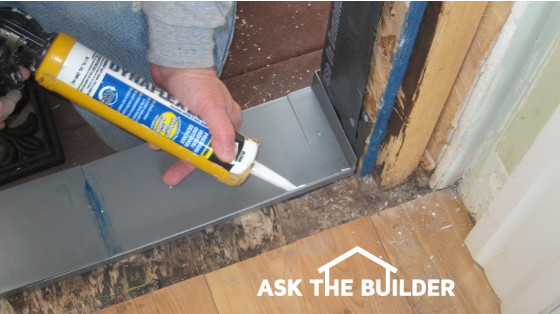Exterior Door Flashing Ninja Tricks
DEAR TIM: When it rains, water leaks into our basement just under our front door. The previous owner installed the door, and much of the work around the house he did we’ve discovered is substandard. What do you think is the cause of the water leak under the front door? How can it be fixed? What should have been done in the first place? If we do nothing, what will happen over time? Sharon P., Nashville, TN
DEAR SHARON: I realize it’s of little consolation, but you’re in a large group of homeowners that suffer from poor workmanship. Some is perpetrated by do-it-yourselfers that don’t have the proper training or attitude, but a frightening amount of poor work is being done by paid individuals trying to pass themselves off as pros.
Sadly, I see an erosion of the quality standard each year. Just last month, I saw an article in one of the top building magazines where the author was telling other builders and roofers that it was perfectly fine to use caulk as a sealant while building a copper chimney flashing. I was aghast at such workmanship and advice. You don't caulk copper flashing joints, you solder them for a permanent leak-free joint.

The door flashing is in place and a bead of caulk is being laid down to prevent air infiltration. Photo Credit: Tim Carter
With respect to your front door, I'm afraid the leak could be traced to any number of potential defects. The first thing I suspect is the installer didn't include a weather membrane under the door threshold. That's the bare minimum that should be done.
It's also possible the leak could be coming from a lack of a sill flashing pan, poor caulking on the sides of the door, a lack of a water membrane on the sides of the door frame, a lack of a flashing above the door, etc. There are several other possible causes of the leak.
The best way, in my opinion, to understand why doors and windows tend to leak at houses is to think about how the exterior wall system works when there is no door or window in the opening.
If your house has wood, metal or vinyl siding, these materials shed water much like shingles on a roof. One piece of siding overlaps the next one such that water running down the wall can't get behind the siding. The overlapping materials shed water very well.
When you install a door or window in an exterior wall, you must do it in such a way that you maintain this overlapping layering of materials. Think of the door as a giant piece of siding.
This means that under the door there needs to be a water membrane that protects the subfloor from water and overlaps the last piece of siding or exterior material that tucks up under the door threshold.
Better yet, you should install a preformed flashing pan under the door or window. I've installed many in my career, even making my own from soldered copper or tin. The front of the flashing pan overlaps the piece of siding that tucks up under the door threshold so that any water that gets under the door is channeled back outdoors.
These flashing pans are sized for just about any width door or window and for the most common wall thicknesses. They're the absolute best defense when it comes to preventing leaks. After the flashing pan is in place, you continue up the sides of the opening with a water membrane that overlaps the sides of the flashing pan. This method channels water back outdoors.
To fix your leaking door, I'm afraid to say it may require removing the door to inspect to see how it was installed. You can get clues as to the leak cause by just removing the exterior wood trim that surrounds the outside of the door. Removing this trim is not hard, and it will readily show you if the required water membranes are installed as well as the mission-critical flashing pan.
Ignoring water leaks under doors and windows is a mistake, especially if your home is constructed with wood framing.
Water can and will promote wood rot. Water leaks can cause vast amounts of damage. Water will fuel hidden mold growth.
If enough wood rot is allowed to occur, you'll suffer from structural damage at some point. It may take years, but floors can sag, beams can fail and roofs can collapse.
You can see why it's so important to hire a true professional that understands how to keep houses dry. It's your job to understand this as well so you can ask the correct questions as you interview contractors that will work on your most valuable asset - your home!
Column 974
One Response to Exterior Door Flashing Ninja Tricks